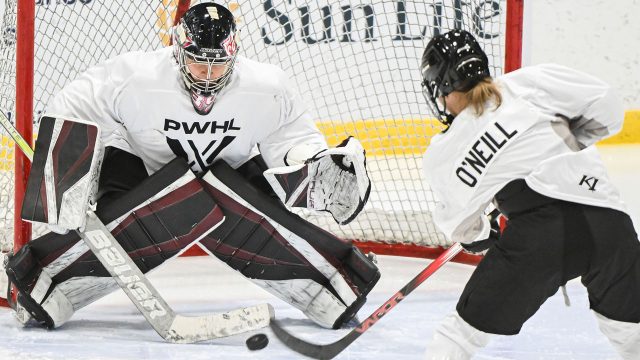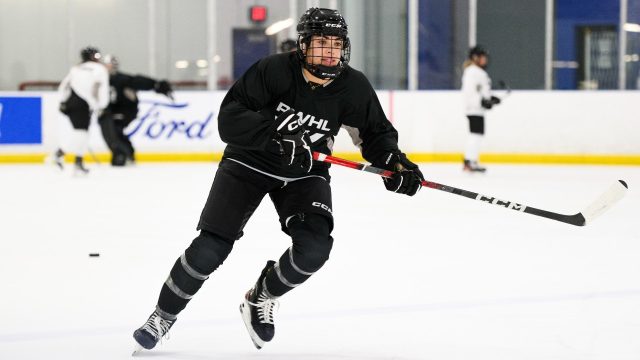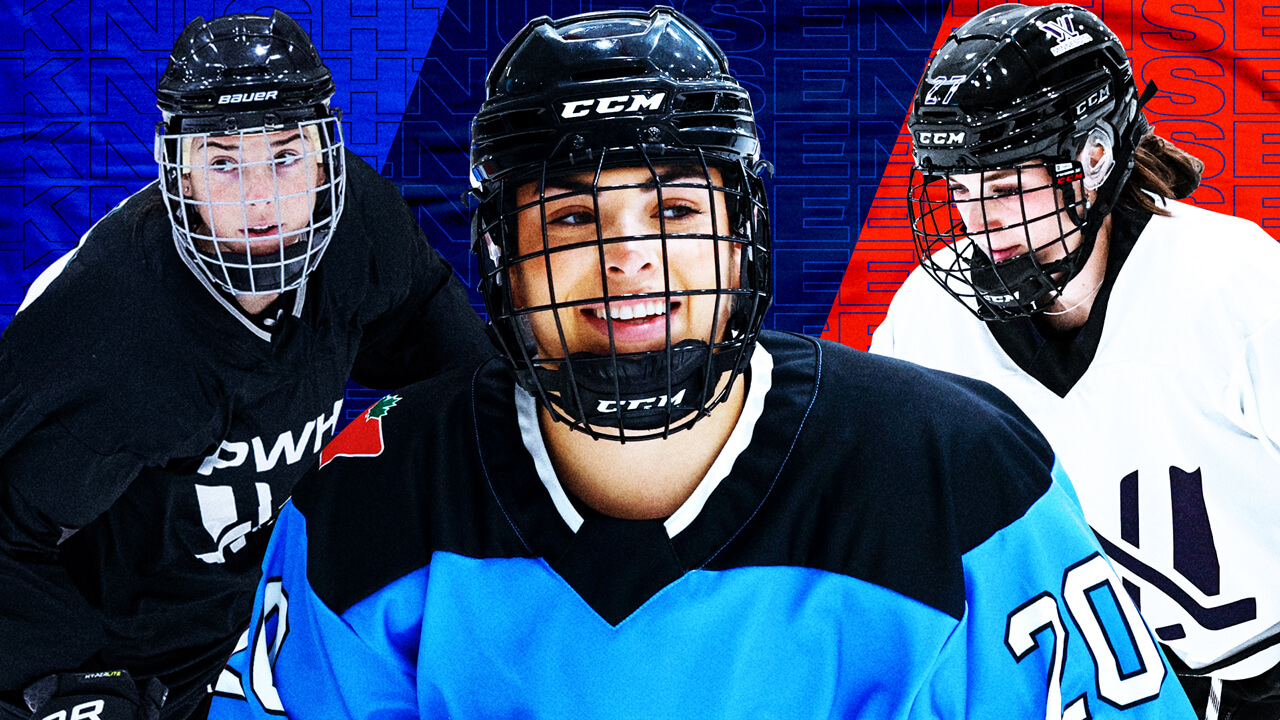
“WE’RE HERE TO STAY”

C
harging toward the net, Sarah Nurse slows up for a moment before turning on the jets again. She makes a quick deke from left to right, then pulls the puck to her backhand and fires it top corner — ping! — right off the inside of the crossbar and in. A collective “woo!” from her teammates watching at centre ice echoes around Rink 2 at Toronto’s Ford Performance Centre as Nurse peels back to join them, a big grin on her face. She holds up a glove for fist bumps. The forward has been working on her shootout attempts, specifically on changing her approach speed, something teammate and goaltender Kristen Campbell suggested when Nurse asked how to make herself more dangerous. “I went three-for-four in shootouts yesterday,” Nurse says, smiling.
Twenty minutes after that slick shootout goal, the 28-year-old is standing outside the Performance Centre gym, where her Toronto team has started their off-ice workout. It’s the last day of November, and players just learned the full details of their 24-game schedule for 2024, the matchups that will make up the inaugural Professional Women’s Hockey League season. And that means Nurse’s New Year’s Eve plans are set.
“I think this year will look definitely different than years in the past — I’ll probably mix in an ice bath, get to bed early and make sure I’m hydrated,” she says, laughing. “I’ll read, have a nice camomile tea — it’s calming. You have to have a bedtime routine. You do. So, I’ll try to be in bed by 10, pop some magnesium, and I’ll be asleep by 10:30.”
Her plans may resemble those of a much older gal but mock her all you want, Nurse isn’t bothered. “We have to be ready to go the next day,” she says. “It’s a big one.” A New Year — and a New League.
On Jan. 1, 2024, Nurse and Toronto will host New York in the first-ever PWHL game. The afternoon tilt at Mattamy Athletic Centre will officially open action for a league that promises stability at last for women’s professional hockey. “It’s incredibly special that we get to be a part of the first game, and we get to host the first game,” Nurse says. “Toronto — this city — is a part of history.”
A league years in the making has come together at lightning speed, with major details like home rinks, practice facilities, and, yes, the schedule trickling out less than two months before puck drop. Even if PWHL brass stayed up all night every night since plans were set in motion in late June, it would be next to impossible for everything to unfurl perfectly prior to a January puck drop. Launching a full league spanning six markets has come with real costs and occasionally ruffled feathers, but one sure thing from Day 1 has been that the PWHL, backed by big money and big names like Billie Jean King, is getting the best players in the world to play against each other regularly. The division that existed — first, in the form of two leagues competing for talent in North America, and then one league that many of the game’s best boycotted — is now over. One single best-on-best league is taking its place.
This is Season 1. The start. And the hope is the PWHL is going places no pro women’s hockey league has ever been before — in other words, that it can be the one North American women’s pro league that never folds, isn’t boycotted, isn’t challenged by another league that lures great players away, and can withstand the inevitable growing pains that come with such a massive new enterprise. The hope is that women can be professional hockey players, full stop — without needing to hold down an additional job to pay the bills. The hope is that Season 1 lays the foundation for a bright future.
This is a portrait of what it was like to experience the breakneck-speed PWHL planning from the perspective of players in all six markets: Toronto, Montreal, Ottawa, Boston, Minnesota, and New York. “The fact that everything’s coming together so quickly is — you know, I wish we had more time, but we don’t,” Boston forward Hilary Knight says.
“So, it’s just happening — and it is happening when it needs to happen.”

T
aylor Heise has walked the red carpet — purple, actually, which is now the signature colour of the PWHL — stopping to sign autographs for young girls clad in minor-hockey sweaters. She’s paused for photo ops with teammates, past and soon-to-be, and mingled among her peers and their families, agents and executives, all gathered under the beams and bright lights of the PWHL’s draft stage in the atrium of CBC’s flagship building in downtown Toronto. Now, all that’s left to do is sit and listen and wait to hear her name.
Everyone in the room knows Heise won’t have to wait long. The 23-year-old Minnesotan and USA Hockey standout has been a lock at No. 1 since the lottery balls landed in favour of her hometown team five days ago. So coveted is the forward and University of Minnesota Gophers co-captain, she’d likely be the first off the board regardless of the market. That it’s Minnesota makes this historic day that much more special for Heise. “Once Minnesota got the first pick, I really started hoping and praying that that was going to be me,” she says.
Heise is one of about 50 draft-eligible individuals in attendance for this moment, a 15-round selection process that will see all six teams pluck from a talent pool of 268 eligible players. It’s a unique draft, and not just because of its snake format. Players have come from all corners of the hockey world: college, the PHF, the PWHPA, and national squads — even some of those who spent 2022-23 on the sidelines are now ready to jump back in.
“I mean, how often do you really throw the best players in the world into a pot and say, ‘Hey, let’s make six brand-new teams?’” says Team Canada forward Jamie Lee Rattray, who’ll go to Boston in the third round. “I don’t think that’ll ever happen again in sports.”
Unlike Rattray and many of the other women waiting to hear their names today, Heise hasn’t been leading the charge for change in women’s hockey these last four years since she has yet to make the jump to the pros. But she has been seeing the landscape shift as she was busy lighting up the NCAA. And today she represents the first face of her sport’s professional future.
She had just wrapped up her freshman season at the University of Minnesota when the Canadian Women’s Hockey League shut its doors in the spring of 2019 — a move that led more than 100 of the world’s best players to unite in a quest for one sustainable, professional league of best-on-best hockey in North America. As the Professional Women’s Hockey Players Association spread its message across Canada and the United States, Heise tore up the Division-I circuit as a sophomore, then as a junior, winning the Patty Kazmaier Award as college hockey’s MVP in 2022.
A new star on Team USA’s World Championship roster that year, Heise learned firsthand from her national squad teammates, including prominent PWHPA members like Knight and Kendall Coyne Schofield, just how rocky the road to the pros could be as they shared thoughts and war stories: The launch of the National Women’s Hockey League (later renamed the Premier Hockey Federation) in 2015 with promises to pay players, only to see salaries suddenly cut; the collapse of the CWHL and the rise of the PWHPA; and the piling up of players in their prime with no stage on which to play meaningful hockey beyond IIHF-sanctioned cross-border battles.
As Heise played her final college games, then headlined Team USA’s golden victory at the women’s worlds in April, so divided was the women’s hockey landscape that it seemed she’d have to pick a side. But on the advice of those same national squad teammates, she waited, hearing rumblings that something big was brewing.
“I just knew that I wanted to play and I wanted to play for a long time,” she says. “Whatever league was going to put me in a spot where I could play and be successful, I was going to take that chance.”
On the evening of June 29, she got her answer. Heise was midway through a movie night, her phone silenced and lying screen-down, when news first broke of the PHF buyout. Okay, fine: it may not have been a movie but an episode or two of Keeping up with the Kardashians. Point is, she was greeted by an onslaught of texts and notifications when she picked up her phone as the final credits rolled.
Investors who’d partnered with the PWHPA had just bought out the PHF, shutting down the seven-team league to make way for the PWHPA’s vision. So a divided landscape was suddenly, apparently… not, and what followed was a summer of equal parts excitement and anxiety as Heise and her peers waited for information. “When this new league came about, we didn’t know what it was going to look like. We didn’t even know if we were going to play this year,” she says.
September brought some answers, and it soon became clear that Heise’s path to the pros would officially begin at a draft on Sept. 18 — the one at which she’s just finished walking the purple carpet. It is the incomparable Billie Jean King, clad in fuchsia-rimmed glasses, who makes that long-awaited announcement in Toronto. “With the first-overall pick in the inaugural Professional Women’s Hockey League draft,” King declares, “Minnesota selects… Taylor Heise.”
Heise gets up and hugs her parents, and then strides to the stage and shakes King’s hand and poses for cameras with a huge smile plastered across her face.
“Being able to stay in Minnesota and play for my home state and in front of my family and friends and loved ones is going to be an experience I will never forget,” she says later.
To say she’s had a whirlwind schedule since draft day would be an understatement, but Heise feels lucky she hasn’t had to orchestrate a cross-country move to a new market. In between Rivalry Series games and rink-hopping to make appearances at events around Minneapolis, the hometown kid has been plenty busy. She’s landed an agent to help navigate this next step of her career.
“I said the second that I figured out I was going there, there was no more complaining for me,” Heise says. “Like, I don’t really care what the [team]name is — as much as those things matter, for me it’s more so like, this is a dream come true.”
She’s also quick to point out this dream is being fulfilled thanks to the generations before her.
“It’s always been about the future. It’s always been, ‘Oh, maybe they [the next generation]can do it,’” says Heise. “This is now where every girl is going to be able to play hockey professionally if she works hard and she’s a part of the top group in the world.
“And I also want to make a point to say, like, it wasn’t me. It wasn’t anyone in my class. It wasn’t anyone younger than me that started this … You look at a Hilary Knight, who’s been working for probably 15 years at this point to get to this moment … It’s all the work those girls did, all that searching and working and playing hockey at the same time.”
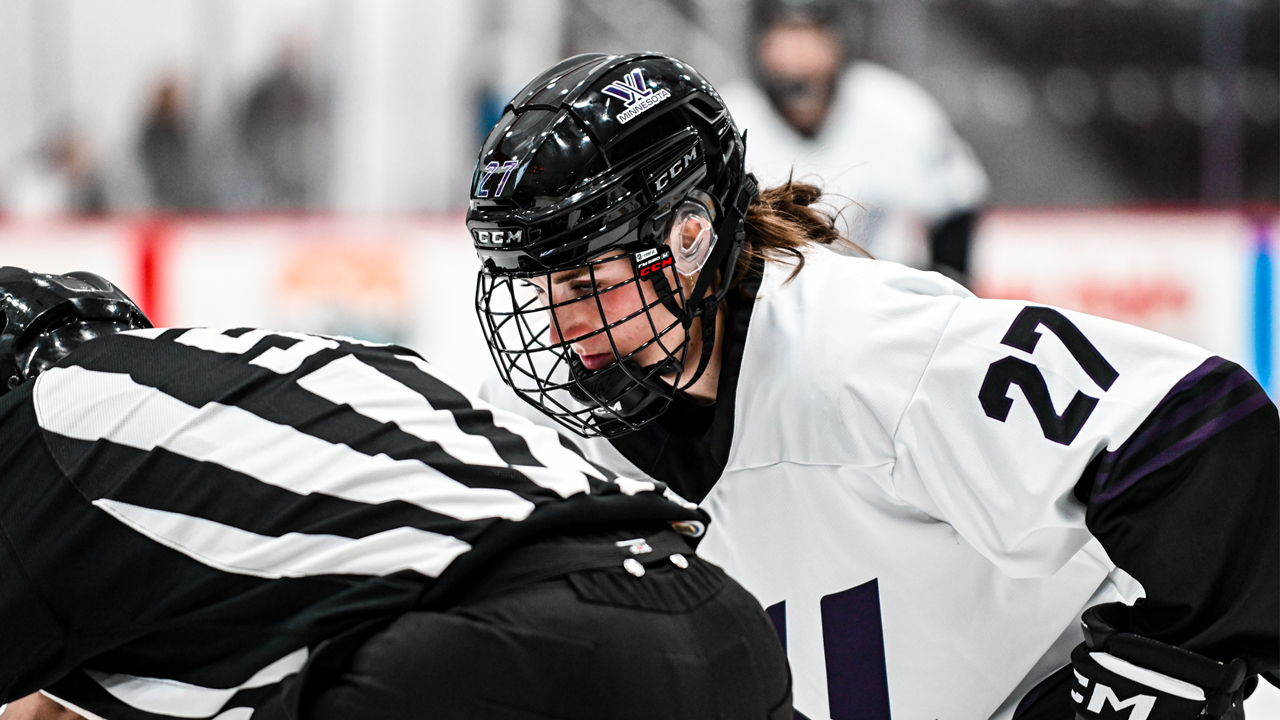
H
ilary Knight set out on the 24-hour drive from her old home (Minnesota) to her new home (Boston), sure she had everything she needed — either with her in the car or making the trip in a shipping container. Anything she didn’t require for the season was headed to her parents’ place in Idaho. The leading point-getter in international women’s hockey arrived at her apartment and unpacked her stuff, and that’s when she discovered a glaring error.
“There were some things that didn’t make it out east that are probably — I am praying — going out west. And that happens to be all the cushions for the couch,” Knight says, laughing, from her bed, where she’s sitting since her couch is on IR. “Hopefully when I go back for Christmas I’ll see, ‘Okay, are they actually here, or what’s going on?’ And I’ll just bring them back in a big hockey bag or something. Those would be nice to have.”
The shell of an oat-coloured couch in Knight’s living room seems cozy compared to Daryl Watts’ furniture situation in Ottawa. It’s mid-November, camp is now underway, and she has yet to order a bedframe. For now, her mattress is still on the floor in the two-bedroom apartment she’s sharing with her best friend Mikyla Grant-Mentis. Grant-Mentis went undrafted in September, so she’s in Ottawa competing for a roster spot, confident enough in her ability to land a contract that she’s leased the apartment with Watts. (Spoiler alert: Grant-Mentis’ confidence will pay off.)
Watts and Grant-Mentis lucked out with a six-month lease that’ll house them through the end of the season, but furnishing it has been a different story.
“It took us so long to find a couch,” Watts says with a laugh. “We had no idea how expensive couches can be — and you have to spend money because if you cheap out it’s not going to be comfortable.”
For the early days of training camp, both Watts and Grant-Mentis are making themselves at home in the team hotel while slowly moving into their place. Watts’s mother is visiting from Toronto for a few days to help set things up, while Watts and Grant-Mentis have been focused on all things hockey.
Blayre Turnbull, meanwhile, is living in the home owned by one of Watts’ and Grant-Mentis’s teammates this season. After signing a three-year deal with Toronto during the league’s first window of free agency, Turnbull moved from Calgary with her husband, Ryan Sommer, into Brianne Jenner’s place in Oakville, Ont. Jenner and her wife, Hayleigh Cudmore, are renting in Ottawa, where Jenner is playing this season.
And though it’s only a four-hour journey from Oakville to the nation’s capital, no player had a move quite like Jenner. She and Cudmore did the drive along with their two-year-old daughter, June, and their two-week-old twins, Fritz and Lowell. (That’s three kids under three, for anyone keeping score at home.) “It’s been a great adventure,” says Jenner, putting a positive spin on what must’ve been, at times, utter chaos. “I’m so grateful to Hayleigh for her unwavering support. She’s been an absolute champion.”
Cudmore certainly deserves all the awards. In the space of a month, she gave birth to twins and moved across Ontario. Jenner’s parents have helped out big-time as the family gets settled. Jenner’s mom moved in with them. “I feel pretty lucky to have the family I do,” Jenner says.
Even without three young kids, picking up and moving for the five-month season is hardly a piece of cake. Turnbull and Sommer rented out their townhouse in Calgary and moved a lot of their belongings into storage before heading east to Jenner’s. “This last month, for me, has been filled with anticipation, and obviously stress and anxiety with moving and figuring out the logistics of everything,” Turnbull says, just after settling in Oakville in mid-November. “But this was one of the things that worked out great — moving into a friend’s house that’s fully furnished, I feel like that made it as easy as possible.”
Sommer and Turnbull brought only the essentials, like clothes, toothbrushes, her hockey equipment, and their Olympic medals — her 2018 silver and 2022 gold, and Sommer’s 2022 bronze. (He was a bobsledder, and they met in Calgary at the gym while they were training for the Olympics.)
Alex Carpenter, meanwhile, found an Airbnb in Stamford, Conn., about a mile away from New York’s practice arena. She moved in after November’s Canada-USA Rivalry Series games. For a couple months before that, the Team USA star had been checking out options in three different New York neighbourhoods, because her team was rumoured to be playing in Albany at MVP Arena, Elmore at UBS Arena (home to the Islanders) and/or at Total Mortgage Arena in Bridgeport, Conn.
A round trip to all three arenas, without traffic, takes five hours, so Carpenter couldn’t choose her new home until the arena was announced in late November. “I wanted to be close to the practice rink,” says Carpenter, who’s a big fan of riding a scooter to work — something she did when she played professionally in China. Now that she’s settled in Connecticut, though, she’s finding it’s a little cold to scoot.
November is busy for the PWHL. Jerseys are released Nov. 14, training camps open a day later, teams’ home venues and opening games are announced Nov. 28, and on the final day of the month, the entire schedule for Season 1 is revealed. As all that news trickles out, Turnbull is trying to stay patient, while major questions still hang in the air. “This last month and a bit has been kind of hard, since the draft,” the 30-year-old says. “It’s super exciting, and I’m so looking forward to starting, but at the same time it’s like, ‘Can we just start already?’ But that’s just me being impatient with not knowing details … I’ve had to kind of focus on staying present every day, with my workouts and my practices and my training, because there’s so much stuff we want to know and learn about. But with that said, we all know it’s getting done, right?”
Answers to most questions are some iteration of Carpenter’s common refrain at this point: “I’m not really sure.” The 29-year-old, a two-time Olympic silver medallist, is fully confident she’ll be sure soon, that everything will come together in time for puck drop.
As for where things stand a month and a half before the inaugural season, Carpenter sums it up like so: “We know mildly what to expect.”

D
aryl Watts is relaxing in her hotel room in Ottawa, happy to be talking hockey after a long off-season without. It’s mid-November, she’s three days into training camp, and this Saturday morning marks the first off-day before a long stretch of practices. She hit the ice for the first time with her teammates on Friday, and already she can’t wait to get back to the rink Sunday morning.
It’s been almost eight months since she last skated in a meaningful game — one more meaningful than she and her Toronto Six teammates knew at the time, their overtime win against the Minnesota Whitecaps making Watts’s squad the seventh and final team to ever hoist the Isobel Cup as PHF champions. Watts was about to board a flight to Boston to visit friends on June 29 when she was notified about an urgent league-wide Zoom meeting. By the time she touched down on the other end, the news was out.
“I land in Boston, I’m walking off the plane, getting service and my phone’s blowing up because my best friends who are part of the PHF are texting me like, ‘Oh my God, our contracts are voided. It’s over. There’s a new league,’” Watts says. “And I was kind of like, ‘What do you mean our contracts are voided?’ Because, well, obviously I had a big contract.”
Last January, Watts put pen to paper on a two-year deal that would see her earn $150,000 in 2023-24 and make her the highest-salaried player in the history of North American women’s professional hockey. The contract ushered in what was supposed to be a new era in the PHF, which had just announced another major hike in teams’ salary caps, up to a record-setting $1.5 million for the 2023-24 season.
But that season never came.
“I was just like, ‘What do you mean?’ There were just so many questions, right?” she says of those first few hours of uncertainty. “But I guess, you know, there wasn’t much I could do.”
Confusion and anxiety clouded the days that followed as the news sunk in. But Watts’ apprehension was quickly replaced with excitement. The bigger picture looked bright.
“Once I got back to Toronto, the conversation was, ‘You know what? This is awesome for women’s hockey.’ Because now there will be, finally, one league, and for how long has the women’s hockey community been trying to establish one professional hockey league? So now, that’s actually going to happen,” she says. “All of the best players in the world will finally be in one league together. So, then I was excited.”
Still, it was sad to say goodbye to the Toronto Six and the PHF — her hometown team and the league that lured her out of a short post-college retirement in 2022 and showed her that her love of hockey and desire for financial security did not have to be at odds.
While the PWHL brings the promise of a truly professional platform, a more financially stable future league-wide and a larger stage on which to showcase players’ talent in true best-on-best fashion, it also brings a pay cut for Watts and many others who’d already signed their PHF pacts when the buyout went down.
As outlined in the CBA, the PWHL’s minimum salary is $35,000. Each roster will have an average salary of $55,000 and is also allotted at least six spots for players earning no less than $80,000 with a contract term capped at three years.
Watts is a firm believer that financial transparency is a major key to growth; money talks, and all that. But in the early days of this league she’s eager to let her play do the talking, and wants to respect the current team and league protocol not to disclose players’ salaries.
“The average salary in that league was going to be higher than what it is in this league. It might take this league a long time to get to where the PHF was,” says Watts. “So, the PHF should still be celebrated.”
Jillian Dempsey has felt that salary shift in a big way, too. She played her entire career with the PHF’s Boston Pride, and is now signed to a one-year contract with PWHL Montreal.
“I think there’s, I don’t want to say a misconception or misperception, I’m not sure, that all of a sudden now everybody’s making some kind of insane money when I think the reality is, a majority of players are somewhere down in that 35, 40, 45 [thousand]range,” says Dempsey, who’s in favour of disclosing players’ salaries, but chose to abide by current protocols. “And before, when you had another career, that money is doable, you know?”
Dempsey did have another career before, as a teacher. “It’s definitely financially significantly different when you don’t have the opportunity to have that career outside of the rink,” Dempsey adds. “It’s a very, I think, big discrepancy between what some players are making and what other players are making. So, it’s just a totally different experience depending on where you fall in that.”
Dempsey holds the PHF records for most career goals, assists, points, and games played. And with the shuttering of the league in June, she always will. For the better part of the past decade, she balanced being a fifth-grade teacher by day and the Boston Pride’s leading scorer on evenings and weekends. And that was exactly how she liked it.
“I know that wasn’t the end game for getting to where we want professional women’s hockey to be,” she acknowledges of her two-job system — an approach to life in the pros most of her peers were rallying against. “[But] I was living the dream, pursuing both my passions.”
A switch to midday practice times for the Pride in 2023 pushed Dempsey to make the difficult decision last spring to take a year-long leave from her students to keep her PHF career going. But the one-year, $80,000 contract she’d signed with the Pride for the upcoming season meant she could afford to drop her day job for a while, and, at 32, her fire to keep playing hockey meant the decision was, ultimately, pretty clear.
“I knew exactly what I was signing up for when I did that,” she says. “And then obviously when the PHF made their announcement, everything was very uncertain, and I wished that I had my teaching then because that would have been nice to have that stability and that routine and something I know I loved instead of just kind of waiting and hoping and wondering for so long.”
On July 2, just a few days after news of the PHF’s demise, the PWHPA’s players’ union voted to ratify the new league’s collective bargaining agreement. Dempsey wishes those crucial foundational conversations around the CBA, free agency, and draft process could’ve featured more faces, more voices, more perspectives.
“Nobody I know from our league had any kind of input,” she says of her PHF peers. “So, unfortunately for us, we just were put into a position where that was what it was and we kind of were forced to accept it or be done, was what it felt like.”
Offered the opportunity, Dempsey would’ve advocated for an expanded free-agency process that could’ve provided veteran players more control over their fates. In reality, only 18 players were afforded that opportunity — each franchise announced three “foundational” free agent signings in early September, with all other players wishing to suit up in the league required to enter via the 15-round draft.
“It was definitely very bizarre and unfortunate to be put into a draft after being a veteran for 10 years, you know? It’s not like you’re fresh out of college and you have that kind of flexibility,” she says. “Like, you go [where you’re drafted]or you don’t play hockey. That draft process was not ideal for veteran players, I think.”
Compassionate circumstance waivers were an option, but Dempsey says they were framed as intended only for the most pressing situations — say, a new baby, or an ailing family member — so she didn’t apply. Besides, she says, things felt pretty straightforward: the only team that had communicated with her prior to the draft was Boston.
“As far as I was concerned, there was no other interest,” she says. “I was intending to stay there and that’s where I wanted to be — I didn’t want to be anywhere else.”
So, when Montreal of all markets called her name with the 66th-overall pick, no one was more surprised than Dempsey, who’d played her entire college and pro career in Boston, within about a 15-mile radius.
“It came as a complete shock to me,” she says. “I had been following along [with the draft online], but I had no idea that was going to happen. I had absolutely no inkling. Like, nobody asked if that was something [I’d be open to].”
Even two months later, newly signed to a one-year deal and sitting in her team hotel in Montreal post-practice with her new team, she’s still digesting the news.
Dempsey wants to make it clear that Montreal’s staff has been great as she settles into life at training camp, and her teammates — many of whom hail from Quebec — have been welcoming. She’ll be moving into fellow forward Sarah Lefort’s house after a brief holiday break and before the puck drops on the season. Two weeks into camp, she knows exactly one word of French: “Just ‘merci,’” she says with a Bostonian lilt.
Montreal is her new hockey home, but Dempsey’s heart will always belong in Boston.
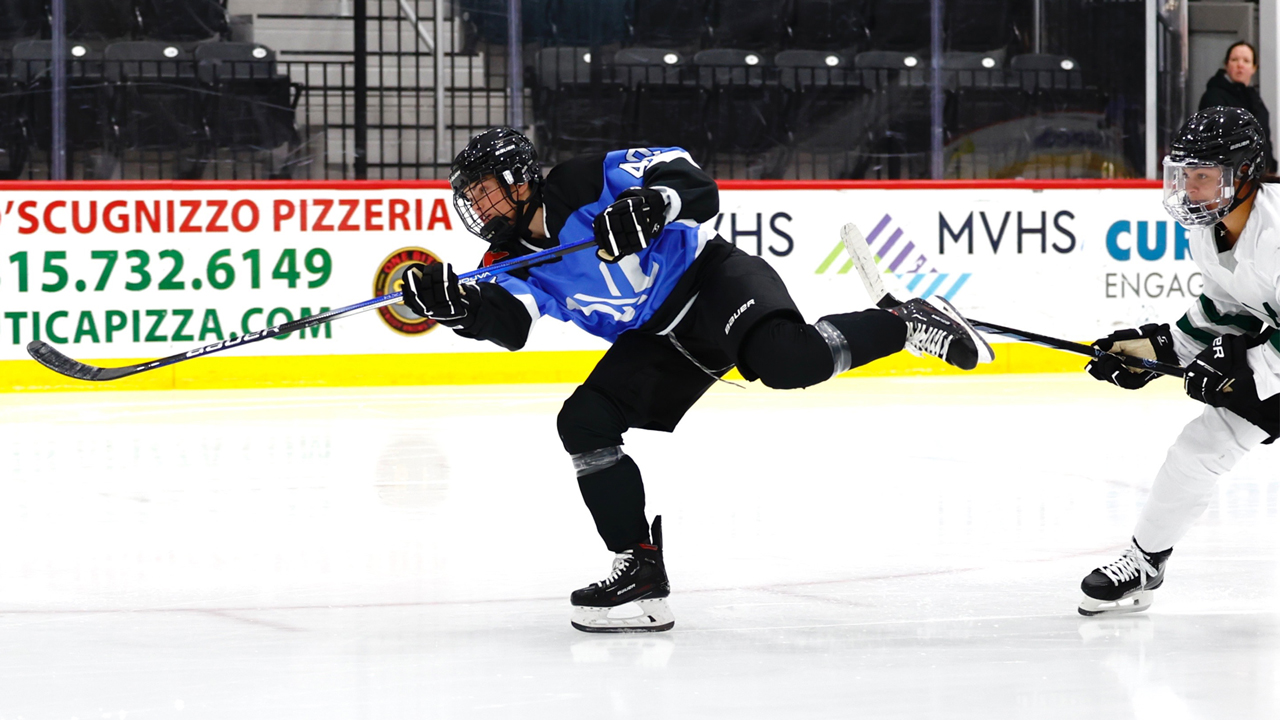
J
amie Lee Rattray describes her prior awareness of her new home city like so: “I knew absolutely nothing.”
The 31-year-old Team Canada veteran was drafted 15th overall to Boston, and she and her three-year-old black lab, Fletcher, are now settled on the city’s east side, in Newton. In mid-January, they’ll be joined by Rattray’s fiancé, Whitney Ellenor, who is able to work remotely.
Rattray, who was born in Ottawa and spent most of the last decade in Toronto, leaned on information from a group chat Boston players set up after the draft to figure out her new home. Once they found out their practice rink would be the Boston Sports Institute, Megan Keller, a Boston College graduate and one of the best defenders on Earth, took the reins as the local tour guide, making suggestions on how to get around and where to eat and live. “It’s a good thing I trusted my teammates because I think I ended up in the right spot,” Rattray says.
Boston’s roster features players from five different countries, including a Swede in net in Emma Soderberg and Swiss star Alina Muller up front. “There’s not a ton of local girls that have lived here, so it’s kind of neat how we’re trying to figure out the city together, and we’ll all go check out different restaurants together,” Rattray says. Her team is bonding quickly as a result, a different feeling from her CWHL days.
“Girls would be working full-time all day, then coming to the rink exhausted, and no one stays after practice because it’s late,” Rattray says of her previous pro experience. “With this setup, we’re hanging out, chatting. We work hard at practice and then have lunch and after we can connect again with teammates. That makes a difference in terms of building a team environment. It’s so much easier.”
Boston has ice for practice every weekday morning, and as Rattray made clear, she and her teammates don’t have to rush off — they can stay to work on skills if they want. There’s time before practice for skill development, too. “In our game, we haven’t had extra ice time, ever,” she says.
This particular December morning, Rattray had a breakfast burrito at the rink with her teammates, practised, did an off-ice lift, and then crushed a steak stir-fry for lunch, again with teammates. Had she needed a wrist or knee taped, the medical staff was there. If she needed a few muscles massaged, same goes. These are all things you’d expect in a pro experience, but they’re firsts for so many in the PWHL.
“It’s crazy to think that after ten years of being out of college and being a quote-unquote ‘pro,’ I think this is the first time where I really do feel professional. I go to the rink, all I’ve got to do is think about: How do I get myself ready for practice and ready to perform?” Rattray says.
Over in Ottawa, Watts has been putting in extra time to make sure she’s ready to perform. She’s been working with former NHLer and strength coach Gary Roberts, in addition to her work this preseason with Ottawa’s training staff.
“I would say my speed has noticeably changed, and that’s one thing I’m so excited about,” Watts says. “And my strength, battling in the corners. I just feel really great. I’m definitely in the best spot I’ve ever been in, and I can’t wait to get the season going.”
Watts is relishing the chance to play alongside new teammates, like Team Canada forward Emily Clark, one of Ottawa’s foundational free-agent signings, with whom Watts struck up quick chemistry during two-on-one drills and scrimmages. And budding international stars like Japan’s Akane Shiga — someone most North American players haven’t had the chance to see up-close until now.
“She’s incredible. Hard shot, really smart, really crafty. She’s fun to watch,” Watts says of Shiga, an undrafted free agent who secured a roster spot for herself at camp.
Watts, who was drafted in the sixth round, opted for a one-year deal herself.
She knows there’s room to grow in this league. Time, too. And she wants to give herself the space to settle into the city and the opportunity to carve out a larger role after Year 1.
“By signing a one-year, I’m hoping to prove myself in the league,” she says.
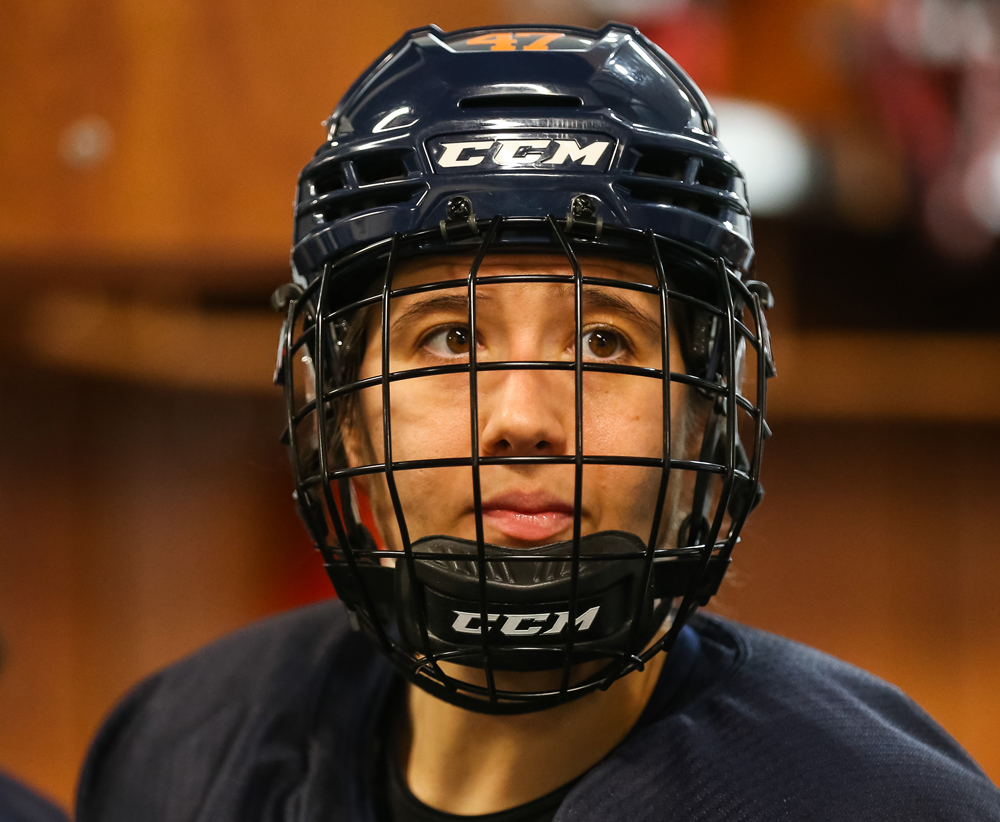
A
s she’s walking around her new Boston neighbourhood, Hilary Knight keeps getting reminded by fans, who stop her to express their excitement, that she’s actually playing professional hockey starting in the new year.
“I know our opener is the third of January but when people approach me I’m still like, ‘Wait, what? This is happening?’” Knight says, laughing. “It doesn’t really feel real yet, I guess.”
It is slowly sinking in for the 34-year-old from California, though, who is a large part of why this is real: Knight was key in bringing the league’s CBA together, alongside Coyne Schofield, Jenner and Nurse. On this particular December day, Knight and her teammates saw their dressing room. Their stalls were set up and ready to go.
“It’s just little moments like that, right?” Knight says. “Like, we built this.”
Over in Toronto, Nurse is pointing toward an office at her team’s practice facility, where 10 team staff members, and a dog, have been in and out. “That’s a fully paid staff. These aren’t volunteers,” she says. “That’s never happened before.” At least, not in her sport at the pro level.
Nurse has been paying close attention to the way the league’s operating, knowing well what players asked for on paper. “When I walked in Day 1, I was definitely sussing everything out, making sure everything was good,” she says. “Honestly, you step into a brand-new situation, this is a completely blank slate for professional women’s hockey. And thus far it has been pretty excellent.”
She calls herself a “prima donna” because she asks for Gatorade in her water bottle, and the team’s staff never forgets. During practices, there’s a camera recording up top and a couple of iPads at ice level for reviewing video. “This is a well-oiled machine,” Nurse says. “Things you wouldn’t even think about, they’re taken care of for us.”
Ask Nurse, Knight, Carpenter — anybody involved with this league, really — and this is just the start. The PWHL is only going to grow and improve in the years ahead.
“Yeah, there’s a lot of things that we’re still working towards — simple things, like team names and logos and, you know, hopefully by Year 2 we’ll have cooler jerseys,” says Watts.
For these players, though, all of that is secondary, extra stuff.
“At the end of the day, we’re going to get on the ice next week and compete,” Watts says. “And that’s awesome.”
In a sport that’s so long been fueled by the dreams of the next generation and the work of adding a few more stepping stones so their path is easier, there’s finally a focus on today.
“As much as little girls, it’s always about them — now, it’s about the time where they can lock in and be like, ‘This is it. That’s what I want to do,’” Heise says. “And it doesn’t have to be about what we can do for them. It’s now about what we, as a group, can all do for each other.”
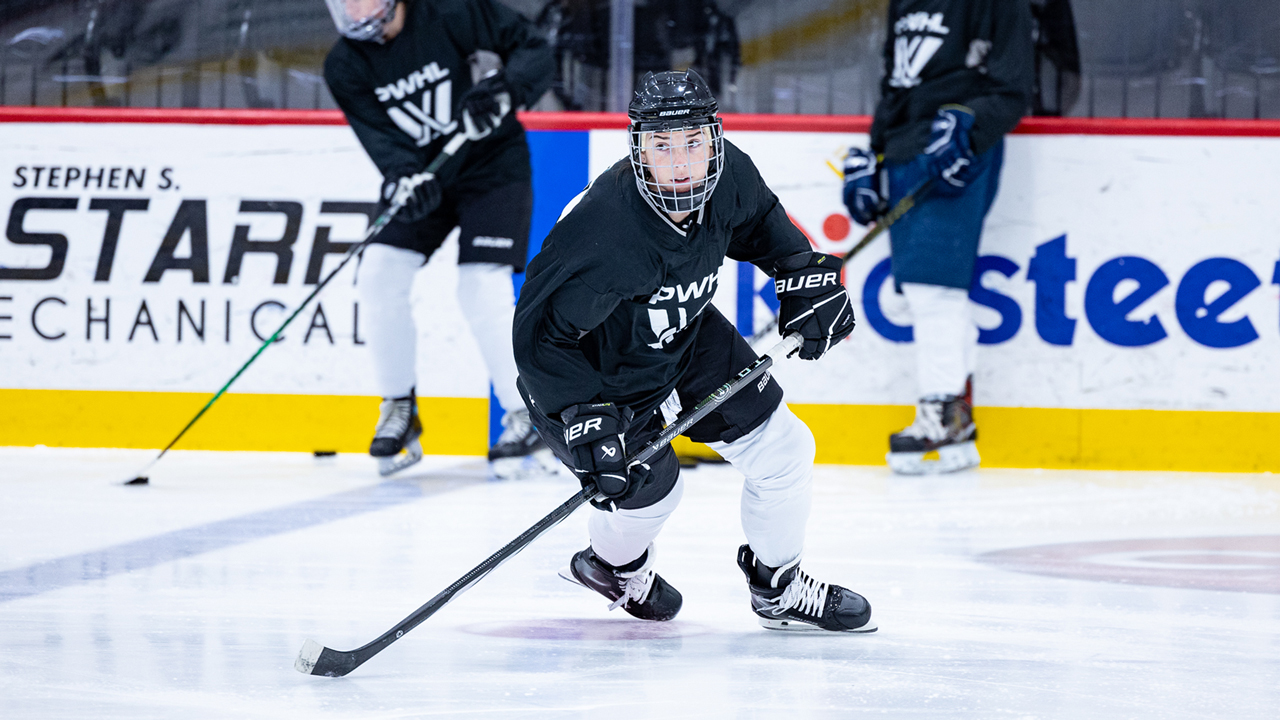
Hilary Knight skates in a preseason practice during the PWHL’s evaluation camp.
K
night has visualized what it’ll look like on opening night at the 6,500-seat Tsongas Center in Lowell, Mass. when Boston plays its first-ever game at home.
“It definitely looks like the lower bowl being filled,” she says. “Just that energy, that Boston fandom. I’m super excited even about our colourway — that green. It’s unique and it’s fun and I just hope it bites as many fans as it can and they get the itch to come to every game, come to some games, whatever it is — because we’re here to stay.”
Judging from what she’s seen in training camp, Knight believes the league will not only be highly skilled, but physical. “It’s going to be a little bit different product than people have seen so far,” she says.
Two days before Knight hits the ice in Boston, Carpenter will suit up in Toronto, on the road with New York. While it’s technically an away game, it’ll feel a little like home for Carpenter whose wife, Steph Klein, is an assistant equipment manager for the Toronto Marlies. Carpenter figures they’ll have a good 15 to 20 friends and family there to watch. “They’ll all definitely have something New York-related on,” she promises.
Nurse will have a healthy contingent in attendance at the league’s first-ever game, too. And none of them are taking advantage of the free ride. “I was like, ‘You guys, I get tickets!’ But a lot of my family just went ahead and bought them anyway,” she says, laughing.
Nurse has visualized stepping onto the ice for the national anthems, or as part of the starting lineup. “I already feel the buzz. I think that is going to be so incredibly special, because you never get your first time back, right? With anything,” she says, laughing. “When you really think about it, to be part of the first-ever game in Toronto, that’s monumental.
“Knock on wood, I hope we’re scoring the first goal in PWHL history,” Nurse adds. “And whoever scores it, sorry, you’re not getting the puck — it is going in the Hockey Hall of Fame.”
But first, her ice bath, her camomile tea, her magnesium and early-to-bed old lady routine on New Year’s Eve.
Nurse has thought about what it’ll be like to retire from the PWHL, when she is actually older.
“I think I’m going to be pretty proud hanging up my skates one day saying: ‘We did this. I’m movin’ on!” she says.
A beat passes and she quickly clarifies that she doesn’t mean moving on to some other league. In the pro women’s hockey landscape, you still need to make those things clear.
“Like, I’m retiring,” she says, laughing. “This league is sticking around forever.”
Courtesy of the PWHL (5); Spencer Colby/CP; Courtesy of the PWHL; Chris Tanouye/Freestyle Photography/Getty Images; Courtesy of the PWHL.


